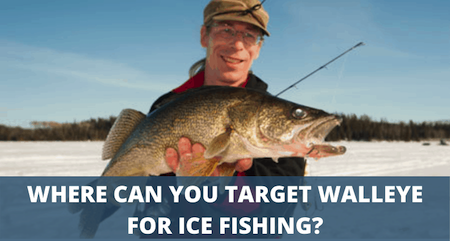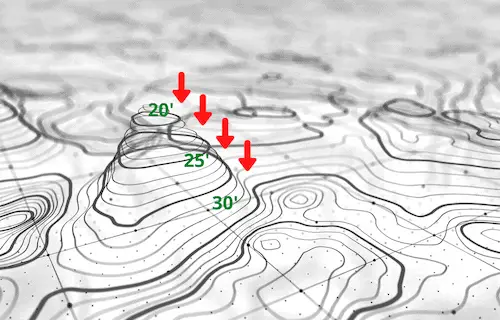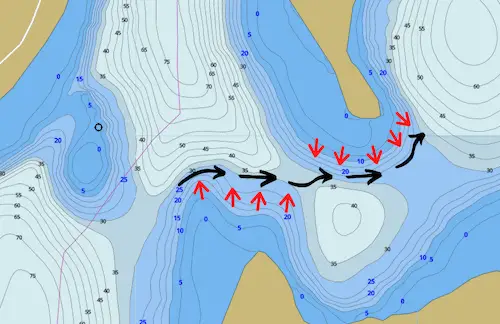Where Can You Find Walleye Ice Fishing?
UPDATED 18 MAY 2023
by Robert Ceran
If you want to catch walleye, probably the single most important factor for success is finding the right location to fish for them.
This is true at all times of the year, but it’s especially challenging during the winter, since they tend to hold in deeper water at this time, which means your favorite summer haunts won’t produce fish anymore.
So if you want to catch them in winter, you need to understand their movements, and how to find the right spots at this time of year.

Here’s how to locate walleye while ice fishing:
In early winter, you’ll find walleye in shallow bays and mud flats where their prey fish congregate.
As temperature gets colder in mid winter, they move into deeper water, and are frequently found near prominent underwater structures such as points, hills and saddles rising up from deep basins.
During late winter, they move into more shallow areas that are close to their spawning grounds near river mouths and inlets.
Read on to get the full scoop.
Where can you target walleye while ice fishing?
In general, winter walleye are found in deeper water than in summer.
The exact depth varies during the course of the winter, and also during the course of each day (for more information on this take a look at our article on what depth should you ice fish for walleye).
Walleye are least active during the day, and their activity peaks at dusk and early night.
In winter, their increased activity in early evening correlates with a move from deeper into more shallow water to hunt their prey fish. For more details, check out our guide on when walleye bite best for ice fishing.
Let’s look at their winter patterns in more detail below.
Best early ice walleye locations
As soon as the ice is thick enough to walk on in early winter, it’s a great time to start ice fishing, as first ice is usually the very best walleye ice fishing time.
The reason why early ice is so good for catching them is because they are intensively feeding at this time, in continuation of their autumn feeding phase.
But this elevated feeding mode is finished by the end of December, so you need to take advantage of it during the first few weeks of ice.
The best early ice walleye locations to target depend on the prey fish their are keyed in on at that time.
If they are feeding on yellow perch, you’ll usually find them in 4-8 feet of water in shallow bays and mud flats with weed growth, relatively close to shore.
Bu if they are feeding on pelagic fish like smelt and cisco instead, you’ll find them in deeper water, where they relate to schools of bait fish in mid water.
If that is the case, you need to find the bait fish schools, and fish in those areas. You should also try to present your lure in midwater, and use colors that mimic their prey.
If you’re not sure what bait to use when you do find walleye, check out our article on the best walleye ice fishing bait.
Where to find mid winter walleye
As winter gets colder, walleye move to deeper water, since this is warmer than the surface. During the daytime in midwinter, they spend a lot of time in basins that are 30-40 feet deep, but often hold close to prominent underwater structures that rise from these basins.
Fishing near prominent structures
Types of structures where walleye concentrate in midwinter:
- Underwater hills, humps, or saddles
- Edges of mudflats with weed growth
- Extensions of shoreline points
The best way to identify these structures is with a GPS hydrographic map, using a mapping software chip (for more information on the top 2 options check out our article on Navionics vs LakeMaster – which is better?).
On most devices you can simply enter the depth range you are looking for, and the map will automatically label the areas of interest (for more details, check out our guide on reading a lake map for walleye ice fishing). The depth range you should look for is between 20 and 30 feet.

How to target underwater hills that rise up to 20-30′ depth
Ideal places to find walleye in midwinter are underwater structures that rise from deeper basins, and that themselves are about 20-30 feet below the surface.
Often you won’t find fish on these structures all day long, but they’ll pass by regularly on their patrols. Towards dusk their visits become more extended, as they start actively hunting perch and other small schooling fish in these areas.
On reservoirs another great underwater structure where you can look for walleye is near the old river bed, which should be easy to find on a hydrographic map.
Often you can find them relating to the outer bends of the river bed, from where they move on to more shallow basins to hunt in the evening.
Fishing at choke points on travel routes
Walleye like to move around in small groups that patrol relatively large areas every day, stopping by the same structures repeatedly.
Because of this habit, another great way to find them in midwinter is to look for “choke points” where fish movement is channeled into a smaller area.
Good choke points to check out include river inlets, the mouths of large bays, as well the straits between two land points (for example, see image below):

How to target choke points between two land points.
When you identify a good choke point, try to fish at a depth of 20-30 feet.
If you’re not sure about the right depth to focus on, drill a series of holes at different depth points, and do ‘hole hopping’ until you find fish, and then concentrate your fishing at that depth.
Another great way to cover a lot of water in search of walleye at a choke point is to ice fish with tip ups.
Instead of moving from hole to hole with your rod, you just set up a whole bunch of tip ups, and thereby cover multiple locations at the same time until you start to notice a pattern in where you’re getting the most bites.
If you’re currently looking for a good rod and reel for walleye ice fishing, check out our review of the top ice fishing rod and reel combo for walleye.
Where to find late ice walleye
During late ice (usually March, but sometimes also April, depending on the location), walleye get ready to spawn, and move towards their spawning grounds.
These areas are often found in river mouths and inlets, especially if there are gravel beds nearby. The spawning grounds are usually very well defined, and in exactly the same place every year.
At this time of the year you can find them in water that’s 10-20 feet deep, in proximity to their spawning grounds. Look for bait fish congregations at this depth, since this is where they feed at this time.
A great way to do this is to use a flasher or ice fishing sonar to find baitfish schools. If this is something you’re interested in, check out our article on what is the best flasher for ice fishing?
Finding walleye in lakes with little structure
Some lakes have very little underwater structure. A perfect example of this is Lake Winnipeg, which covers a huge expanse of area and is one of the top walleye producing waters in Canada, but hardly has any underwater structure.
The lake shoreline slopes gently into a huge shallow basin that’s more or less uniform in depth.
On lakes like this, the best way to locate them is by finding the choke points on their travel routes and then doing systematic hole hopping in these locations.
Finally, another great tool for locating walleye under the ice is a good ice fishing camera. If this is something that interests you, check out our review of Aqua-Vu vs Marcum cameras.
